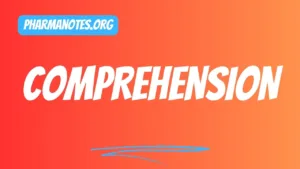Comprehension

Comprehension
Objective
At the end of this session, students will be able to:
• Describe the various techniques of reading
• Apply reading techniques for comprehension
• Practise effective reading
• Explain different representations in complex documents
• Apply strategies to comprehend alphanumerical documents
• Practise reading complex documents
Reading
Reading comprehension is defined as the level of understanding of a text/message. The understanding comes from the interaction between the words that are written and how they trigger knowledge outside the text/message.
Proficient reading depends on the ability to recognize words quickly and effortlessly.
It is also determined by an individual’s cognitive development.
Three Main Reasons Why People Want to Read:
1. Acquire knowledge
2. Professional/career growth
3. Liking
Importance of Reading
Reading helps to:
• Develop the mental abilities
• Discover new things/places
• Nurture creativity
• Increase general awareness and knowledge
• Improve Vocabulary and spelling
Benefits of Reading
Learning to read warrants expertise in 5 key areas:
• Phonemic awareness: Awareness of the sound of the alphabets
• Phonics: A method of teaching people to read by correlating sounds with symbols in an alphabetic writing system
• Comprehension: The ability to understand
• Vocabulary: Knowledge of words and their meanings
• Fluency: Ability to read/speak without interruptions
Basic Steps for Reading to Learn
• Figure out the purpose for reading
• Attend to the parts of the text that are relevant to the identified purpose
• Check comprehension while reading and when the reading task is completed. For example – After reading a passage, paraphrase the same in your own words without looking at the text
• Select strategies that are appropriate to the reading task and use them flexibly and interactively.
For example – Using skimming and scanning techniques
Reading techniques
Skimming- It is sometimes referred to as gist reading. Skimming may help in knowing what the text is about at its most basic level. This technique is used typically while reading a magazine or newspaper, and it would help in mentally and quickly shortlisting those articles which can be considered for a deeper read.
Example: skimming to search for a name in a telephone directory.
Scanning- It involves browsing through the text for information.
Example: Reading a guidebook of a historical city.
Ways to Improve Reading Comprehension
• Choose a special reading place
• Read aloud to someone
• Be read aloud by someone
• Skimming/Reading
• Mapping a text
• Annotating a text
Reading Complex Documents: An Introduction
Complex article and document contains text, tables, graphs, names, numbers, and formulas.
Complex documents like project documents, trade journals, blogs, business books or eBooks, most of them are read regularly as part of jobs, and to develop skills and knowledge.
Iterative Reading of Complex Documents
Reading means more than simply decoding words. Reader must also be able to read with understanding and construct meaning from text.
Iterative reading of complex documents include:
• Understanding the document structure
• Know the purpose
• Understanding the document for
Relevant information
Tables and images
Text
Numerical results
• Understanding the context
• Reproducing the results
Complex Text
Reading means more than simply decoding words. Reader must also be able to read with understanding and construct meaning from text.
Reading complex text requires
• Setting a purpose for reading
• Activating prior knowledge
• Selecting appropriate reading strategies
• Decoding: the ability to apply knowledge of letter-sound relationships, including knowledge of letter patterns, to correctly pronounce written words
• Fluency: the ability to read a text correctly and quickly
Complex Images
Complex images contain substantial information – more than can be conveyed in a short phrase or sentence. These are typically:
• Graphs and charts, including flow charts and organizational charts
• Diagrams and illustrations where the page text relies on the user being able to understand the image
• Maps showing locations or other information such as weather systems
Representations in Complex Documents – Bar Graph
Representations in Complex Documents- Line Graph
Representations in Complex Documents – Pie Chart
Representations in Complex Documents – Picture Graph
Representations in Complex Documents – Excel Sheet
Representations in Complex Documents – Report
Strategies to Comprehend Alphanumerical Documents
• Read title-carefully read the title of the graph, chart or table
• Look at key- understand what each part of the key (chart or graph) means
• Read other titles-read the title of each row and/or column on a table
• Look at figure before questions-Get a general understanding of what the graph, chart or table’s information relays before looking at the question
• Read carefully- Carefully read the question to figure out what information you’re going to be looking for
• Make sure you understand which part(s) of the graph, chart or table will provide with the relevant information
Summary
• Reading is a multifaceted process that develops only with practice.
• People read for many different reasons, the goal is to derive some understanding of what the writer is trying to convey and make use of that information – whether for fact gathering, learning a new skill, or for pleasure. That’s why reading comprehension skills are so important.
• Select strategies that are appropriate to the reading task and use them flexibly and interactively.
For example – Using skimming and scanning techniques
• Complex article and document contains text, tables, graphs, names, numbers, formulas
• Iterative reading of complex documents include:
Understanding the document structure
Know the purpose
Understanding the context
Reproducing the results
• Reading complex text requires setting a purpose for reading and activating prior knowledge
• Complex images contain substantial information – more than can be conveyed in a short phrase or sentence
• Representations in complex documents includes bar graph, excel, charts etc.
• Apply strategies to comprehend alphanumerical documents
Also, Visit:
B. Pharma Notes | B. Pharma Notes | Study material Bachelor of Pharmacy pdf






